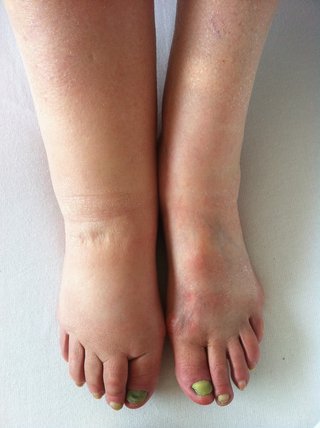Lymphoedema is a long-term condition that causes swelling in the body's tissues. It can affect any part of the body but usually happens in the arms or legs.
Lymphoedema develops when the lymphatic system does not work properly. The lymphatic system is a network of channels and glands throughout the body. It helps fight infection and remove excess fluid.
It's important to diagnose and treat lymphoedema as soon as possible. Without treatment, it can get worse or lead to cellulitis.

Symptoms of lymphoedema
The main symptom of lymphoedema is swelling in all or part of a limb (arm or leg). It can affect other parts of the body too.
At first, the swelling may come and go. It may get worse during the day and improve overnight. Without treatment, it usually becomes more severe and does not go away.
Other symptoms in an affected body part can include:
- an aching, heavy feeling
- problems moving the body part
- skin infections
- hard, tight skin
- folds in the skin
- wart-like growths on the skin
- fluid leaking through the skin
Your clothes, jewellery or watches may feel tight or uncomfortable.
Non-urgent advice: Contact your GP if you:
- have swelling in your arms and legs or other symptoms of lymphoedema
If you had cancer treatment, you may also contact your consultant.
Causes of lymphoedema
The cause of lymphoedema is usually a problem with the lymphatic system.
There are 2 main types of lymphoedema:
- primary lymphoedema - when a change in the genes affects the development of the lymphatic system
- secondary lymphoedema - when another problem affects the lymphatic system
Primary lymphoedema is rare. It can develop at birth, during adolescence or later in life. It usually happens in the legs.
Causes of secondary lymphoedema include:
- cancer treatment
- problems with blood vessels and blood flow
- lack of activity
- obesity
Who's affected by lymphoedema
Around 20,000 people in Ireland are living with lymphoedema.
Primary lymphoedema is rare. It may affect around 1 in 6,000 people.
Secondary lymphoedema is more common. It may affect around 4 in 1,000 people. The cause of over half of these cases is problems with blood vessels and blood flow.
Secondary lymphoedema and cancer
The risk of lymphoedema depends on the type of cancer or cancer treatment.
Your treatment team will tell you if your cancer or cancer treatment could cause lymphoedema. They will tell you how to reduce your risk.
They will try to plan a treatment that avoids damage to your lymph nodes if possible. Lymph nodes are pea-sized lumps of tissue that contain white blood cells. They help remove bacteria, viruses and other causes of infection from your body.
Diagnosing lymphoedema
Your GP can diagnose lymphoedema by:
- asking about your symptoms and medical history
- examining the affected limb and measuring it to see if it's enlarged
The GP may refer you to a specialist for further assessment.
You may need more tests to assess and track your condition.
Treating lymphoedema
There's no cure for lymphoedema. But treatment can reduce fluid build-up and improve the flow of fluid through the lymphatic system. This can improve your symptoms.
Treatment may include:
- wearing compression garments or bandages
- taking care of your skin
- moving and exercising often
- having a healthy diet and lifestyle
- using specialised massage techniques
Complications of lymphoedema
Complications of lymphoedema include cellulitis, low mood or depression.
Cellulitis
The excess fluid in your tissues from lymphoedema increases your risk of infection.
Cellulitis is a bacterial infection of the dermis (deep layer of skin). Cellulitis can cause and be a complication of lymphoedema.
Symptoms of cellulitis can include:
- redness and a feeling of heat in the skin
- pain and increased swelling in the affected area
- a high temperature
- chills
The treatment for cellulitis is antibiotics.
In severe cases, you may need treatment in hospital. You will be given fluids and antibiotics intravenously (directly into a vein by injection).
Impact on your mental health
You may feel distressed, angry or low about the lymphoedema. These feelings may reduce over time as you manage your condition. But sometimes they can lead to depression.
If the negative feelings do not go away, contact your GP or your lymphoedema treatment team. They can refer you for counselling or prescribe treatment for depression.
Talking to other people with lymphoedema can also help reduce feelings of isolation, stress and anxiety.
Living Well programme
Living Well is a free self-management programme for people with a long-term health condition. It provides workshops and resources to help you manage your condition better.
Content supplied by the NHS and adapted for Ireland by the HSE
